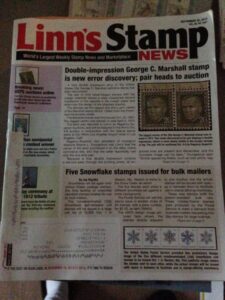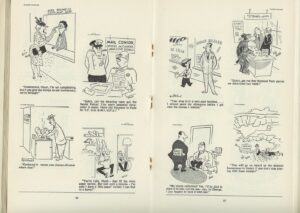 Philatelists of earlier generations grew up with a wealth of publications and literature that makes many of today’s collectors envious. The Internet has meant that one can read about stamps any time for free, but the quality of what is written has diminished significantly with the decline of print publications. Forty years ago, stamp collectors had numerous active weekly publications all vying for subscribers. The best of them— Linn’s and Western— had serious stamp articles, good gossip, investment articles, and interesting advertisements. The monthly magazines were more scholarly in format, and there were many of them too. The main difference between the older day with print magazines and newspapers and today with the internet is editors. Today, there is a constant barrage of opinion and information on websites and chat rooms, but the philatelic editors of forty years ago supplied peer review. Editors like Michael Laurence of Linn’s really knew their stuff, and for an article to make it into his magazine it had to be both interesting and true (Mike was one of the best editors to ever grace our hobby). Today, much of what is written may be accurate, but much is not. And philatelists really have no way of knowing, and many of the chat rooms are forums for preening bullies who dominate the conversations and intimidate newcomers.
Philatelists of earlier generations grew up with a wealth of publications and literature that makes many of today’s collectors envious. The Internet has meant that one can read about stamps any time for free, but the quality of what is written has diminished significantly with the decline of print publications. Forty years ago, stamp collectors had numerous active weekly publications all vying for subscribers. The best of them— Linn’s and Western— had serious stamp articles, good gossip, investment articles, and interesting advertisements. The monthly magazines were more scholarly in format, and there were many of them too. The main difference between the older day with print magazines and newspapers and today with the internet is editors. Today, there is a constant barrage of opinion and information on websites and chat rooms, but the philatelic editors of forty years ago supplied peer review. Editors like Michael Laurence of Linn’s really knew their stuff, and for an article to make it into his magazine it had to be both interesting and true (Mike was one of the best editors to ever grace our hobby). Today, much of what is written may be accurate, but much is not. And philatelists really have no way of knowing, and many of the chat rooms are forums for preening bullies who dominate the conversations and intimidate newcomers.
The cornucopia of philatelic literature fifty years ago was so plentiful that there were many philatelic niche publications. Today’s stamp magazines struggle to get enough readership to survive, but magazines of the 1950s and 1960s could afford to cast a much narrower net. Many were more labors of love than profit making ventures, and if the magazine could find enough advertising it could survive. One of the most interesting and well received magazines of this era was the bi-weekly Stamp Wholesaler. Published and edited by Lucius Jackson, the Stamp Wholesaler was devoted just to stamp dealers and largely consisted of articles designed to help dealers manage inventory, know where and how to buy, and market their stamps. The tone of the writing was what made it so fun. Looking back, Jackson must have been a careful editor (or wrote most of the articles himself under pseudonyms). The tone was remarkably consistent, wry and warm and accepting of the trials and tribulations of stamp dealing. The advertisements were for companies that made and supplied stamp packets (remember them) or stamp mounts or albums. When stamp shops died out thirty years ago, the dealers to whom these ads were pitched went out of business, and the Stamp Wholesaler lost its economic base and ceased publication.
There was one writer who wrote for the Stamp Wholesaler who deserves a hat tip. His name was Ken Lake, and he was a British stamp dealer who wrote for the Stamp Wholesaler under the nom de plume of Mentor. Few people today have heard of Ken, but in his day he was as good a writer as there was, combining charm and wit and good advice. For his Stamp Wholesaler writing, Ken used “Mentor” and his real name was always trade secret (although why he wanted anonymity is hard to say. He said it was because he could then say what he wanted without fear of repercussions, but I think it was more just personal reticence). If you can find some old copies of the Stamp Wholesaler I am sure you would enjoy them. And Ken Lake (Mentor) is really on a par with Pat Hearst as one of the top two or three writers that our hobby has produced.

